Are you wondering what is the best method for long term food storage? By storing food properly, you can extend the freshness of your products over a longer duration. Good organisation in the kitchen and the right storage methods can help you avoid wasting food while preserving its nutritional value. In this article, we will outline some clever ways to store food to prolong its shelf life and keep it fresh.
How do you store loose produce in the kitchen?
Storing dry foods is probably the least of your worries. Simply choose the right containers. For products such as pasta, rice, flour, peas or sugar, glass containers or jars with a tight seal will work well. By pouring them into a glass container as soon as you open them, you can avoid unpleasant surprises. Storing food in glass keeps it fresher for longer and protects it from insects such as the mealworm and breadfruit beetle. It is also a good idea to keep spices in glass containers so that they retain their aroma and freshness for longer. If you prefer lighter packaging, you can opt for plastic containers for dry food. In this case, too, it is a good idea to opt for suggestions with an airtight seal.
When it comes to food products, it is worth taking care to label them appropriately. To avoid confusion and mistake, put the date the product was first opened on the container. You can use stickers and write it on with a marker or buy clever containers with a date stamp on the lid. This makes it easy to check which products should be used up first.
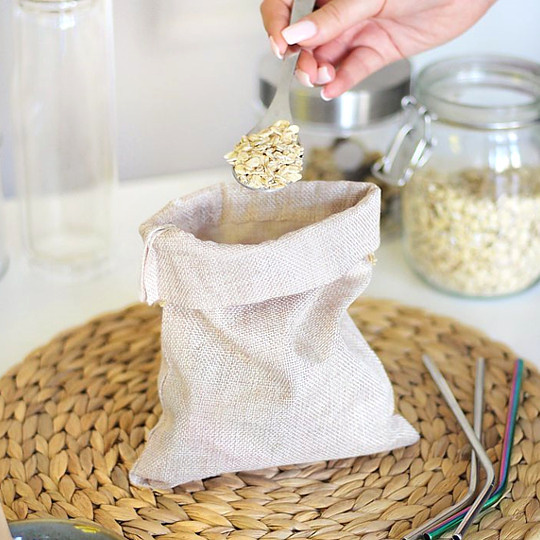
Organisation of bulk products in burlap bags
How to store animal fats and vegetable oils?
The proper storage of vegetable oils requires certain precautions. It is important to put them in a dark place, as light can cause changes in the composition of the fat. Buy oils in dark bottles to protect against these adverse changes. Storing vegetable oils at room temperature is usually the best option – with the exception of linseed oil, which should stand in the fridge. Store rapeseed, sunflower, coconut and sesame oils at 18-20°C, as should olive oil.
Storing animal fats, on the other hand, requires much lower temperatures. Butter , margarine, lard or bacon should be kept in the fridge. However, butter can be safely stored outside the refrigerator for up to seven days. It is then advisable to place it in a glass container and avoid exposure to sunlight and high temperatures. Butter and margarine can also be frozen, but should not be stored in the freezer for more than 6-9 months.
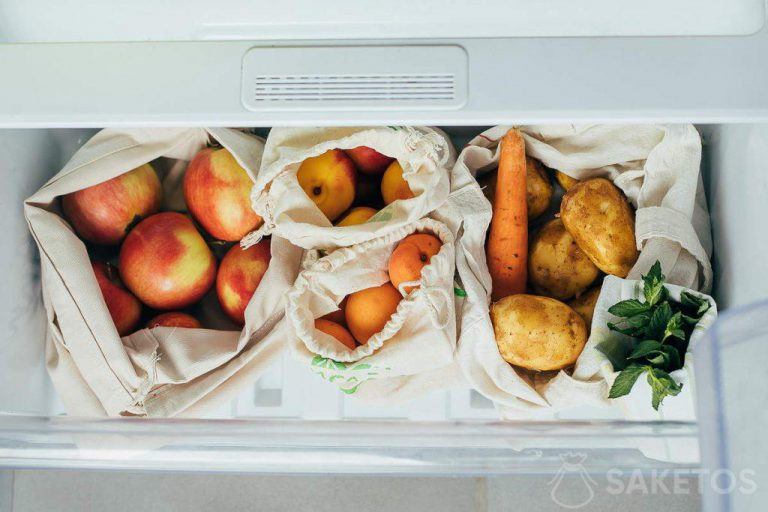
Fabric pouches – ideal for organizing fruit and vegetables in your pantry!
You cannot store all vegetables and fruits in the fridge!
Many people have the habit of storing fruit in the fridge, but this is not always the best way. Which fruits should we not put in the fridge? First and foremost bananas, avocados, pineapples, mangoes, pears, nectarines, apples, plums and citrus fruits. Low temperatures can affect their taste, aroma and texture. Additionally, some foods absorb fridge odors, impacting taste. Watermelons, though enjoyed cold, dislike low temperatures. Keep dried fruit out of the fridge. Delicate fruits like strawberries, raspberries, and blueberries can be refrigerated if properly protected. Grapes, too, can be refrigerated but should remain unwashed.
When storing vegetables, it’s essential to use the fridge judiciously. Onions, garlic, potatoes, and tomatoes should avoid the fridge, as cold temperatures can diminish their health benefits and flavor. Instead, refrigerate green beans, lettuce, arugula, spinach, and pre-packaged vegetables. In theory, carrots or celery should also be kept refrigerated, but they dry out quickly in the fridge, so a far better option is to put them in a linen bag first and then in the fridge.
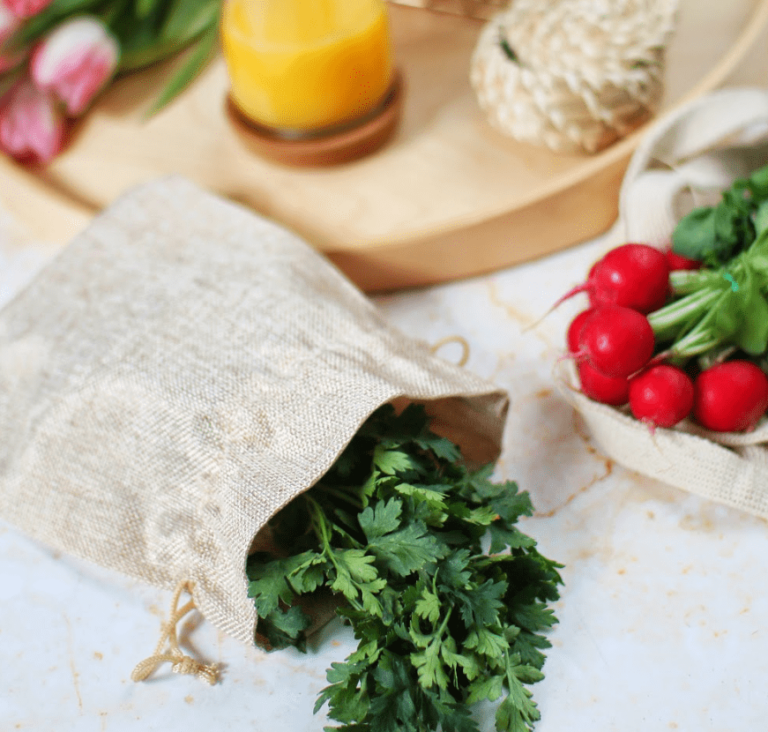
Cloth pouches designed for storing fruits and vegetables
The fruit and vegetables that we eat every day should always be on hand. Some fruit can be stored on top, in bowls or baskets. Larger quantities can be put out on the balcony in a wooden box. However, it is important that they are not exposed to temperatures below 0 degrees. Special kitchen drawers with holes or mesh bottoms are also a very interesting and modern solution, which provide optimal storage conditions for apples, potatoes or carrots. Root vegetables can also be stored in canvas or jute bags, covered with sawdust.
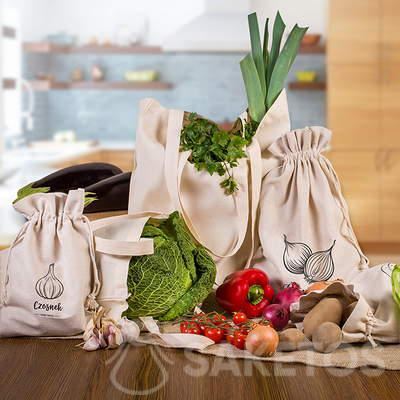
Eco-friendly bags and shopping totes crafted from cotton and linen
Food storage in the fridge
The right temperature in the fridge is extremely important for keeping food fresh. It should be around 4-5°C. It is worth checking the settings and adjusting them if necessary. Good organisation of the space is also important. This can help to store food in a way that does not compromise its properties. Use different compartments, containers and trays to keep things tidy and prevent odours from mixing. Store products in the right places: leave the lower shelves for meat and fish, the upper shelves for ready meals and sauces, and the doors for products with a longer shelf life. The drawer is usually for vegetables and fruit. And how do you store prepared food? If you have ready-made dishes at home, place them in the appropriate containers and mark the date of preparation. You can also freeze ready-made dishes to keep them fresh for longer.
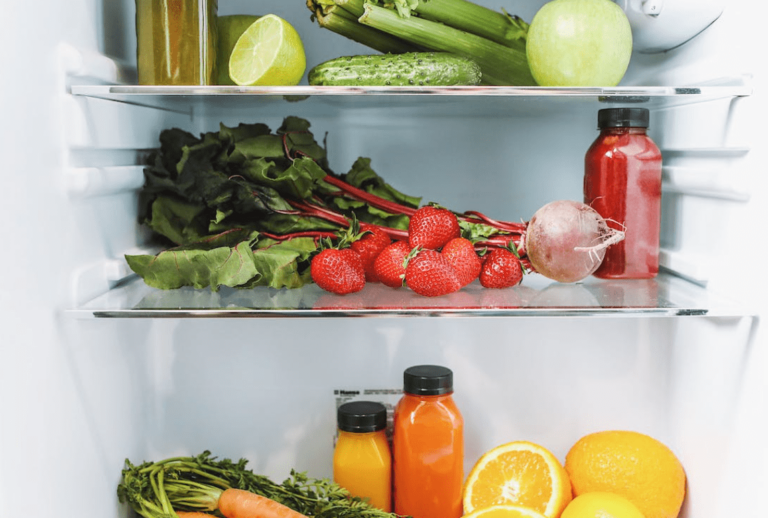
Kitchen Food Storage Solutions: Maximizing Refrigerator Space
How do you store bread?
Bread, rolls or baguettes require special storage conditions. The best solution is to place them in a breadbox or linen bag to keep them moist. Avoid storing bread in plastic bags, as this can affect its shelf life and quality. Fresh bread and rolls can also be frozen to enjoy their softness and flavour once thawed. However, thawed bread should be consumed quickly.
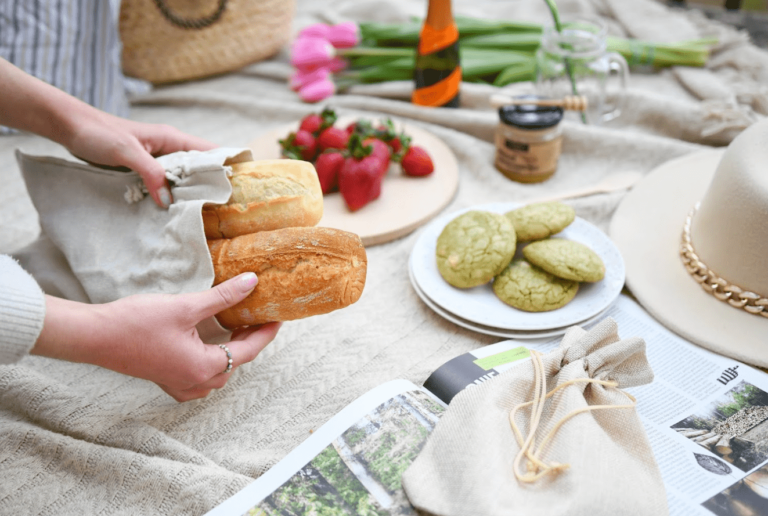
Storing food in cloth bags
Which method of food storage is the best?
There are several tried and tested ways of storing food that definitely prolong its freshness. What are these ways?
- Vacuum packing – one of the most effective methods of food storage. With this technique, you can remove the air from the packaging, which protects the products from oxidation and prolongs their freshness. You can use special vacuum bags or containers with a vacuum function.
- Freezing – works great for storing food for longer periods of time. You can freeze meat, fish, bread, vegetables, fruit and many other products. However, it is worth remembering that each item has a specific freezer storage time.
- A well-organized pantry simplifies storing and maintaining tidiness. Utilize shelves, baskets, and bins to aid in organization and prevent food waste.
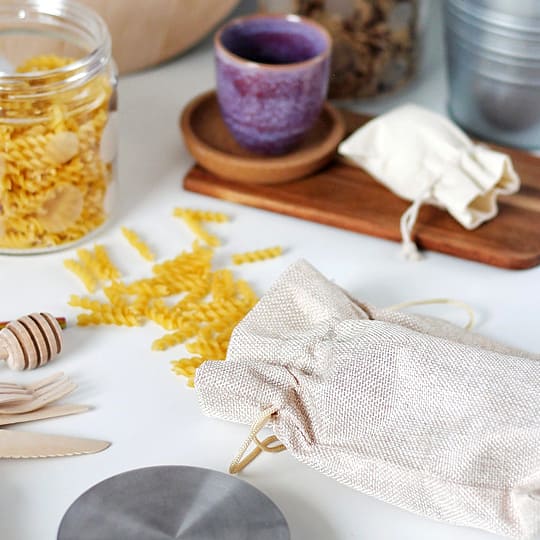
Versatile applications of fabric pouches for food storage
Proper storage of food is key to keeping it fresh and tasty. Take advantage of storage methods such as using the right containers, vacuum packing, freezing and good organisation of fridge space. Also remember to label products so you know when they have gone into the fridge or freezer. With these practical tips, you will enjoy fresh food for longer. Opt for eco-friendly solutions too. Store food in glass or wooden containers, forgo plastic at the shop and use cloth bags.


